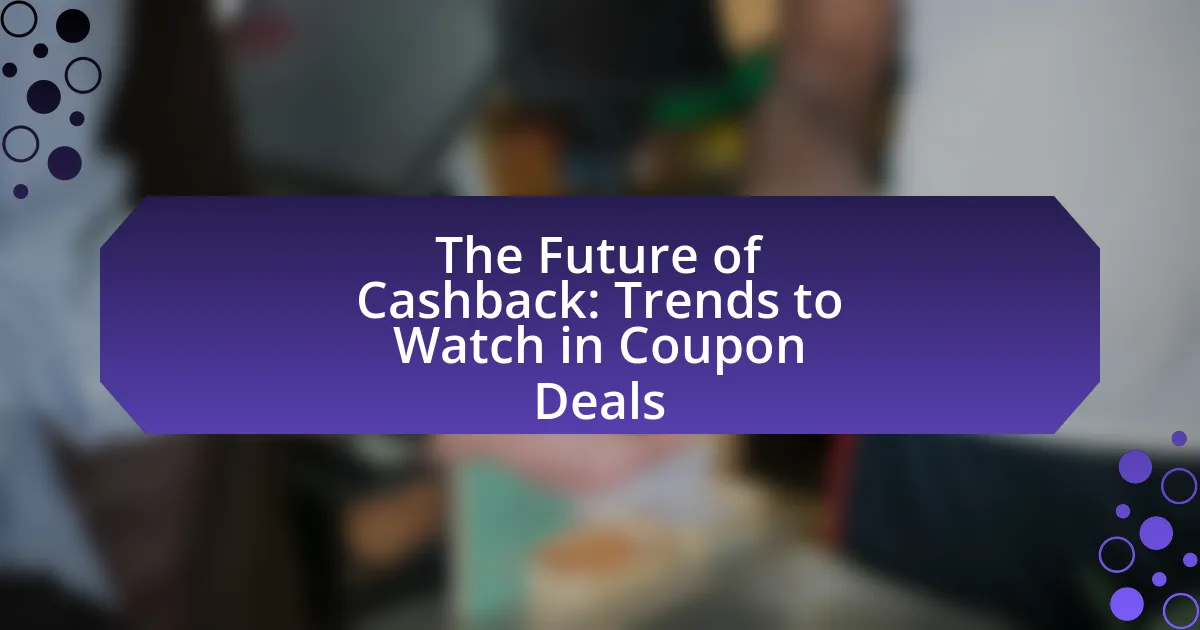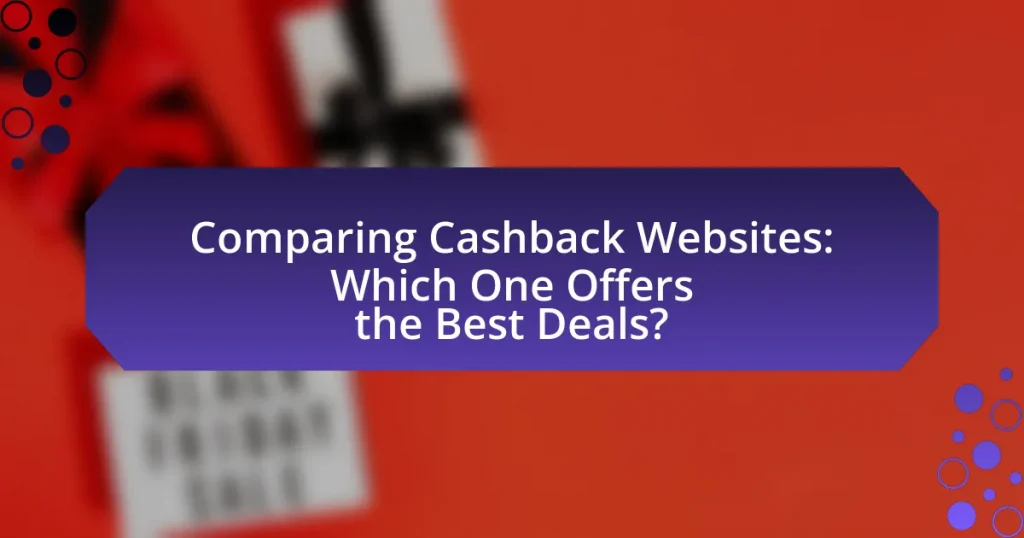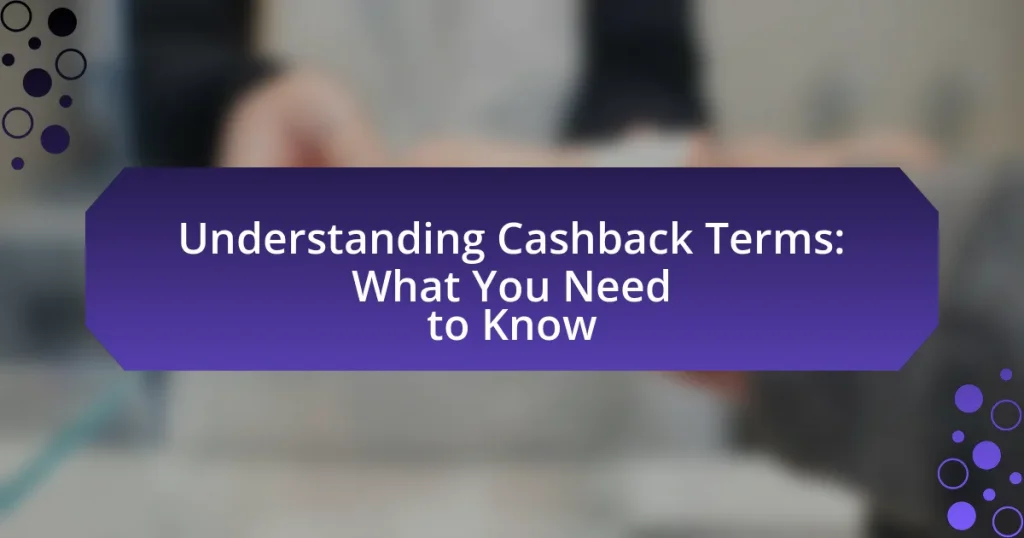The article focuses on the future of cashback and coupon deals, highlighting emerging trends such as the integration of digital wallets, personalized offers driven by data analytics, and the influence of social media and influencers in marketing strategies. It discusses how technology, particularly AI and machine learning, is shaping personalized coupon deals and enhancing user engagement through mobile applications. Additionally, the article examines consumer behaviors that drive changes in cashback programs, the challenges facing these programs, and the evolving partnerships between brands and cashback platforms. Key factors influencing consumer loyalty, as well as best practices for maximizing cashback benefits, are also addressed, providing a comprehensive overview of the current landscape and future developments in cashback offers.

What are the emerging trends in cashback and coupon deals?
Emerging trends in cashback and coupon deals include the integration of digital wallets and mobile payment systems, which enhance user convenience and engagement. As of 2023, a significant increase in personalized offers driven by data analytics allows companies to tailor promotions based on consumer behavior, leading to higher redemption rates. Additionally, the rise of social media platforms as marketing channels has facilitated influencer partnerships, promoting cashback and coupon deals to targeted audiences effectively. According to a report by eMarketer, mobile coupon usage is projected to reach 97 million users in the U.S. by 2024, highlighting the growing reliance on mobile technology in this sector.
How is technology influencing cashback offers?
Technology is significantly influencing cashback offers by enabling real-time data analytics and personalized marketing strategies. Retailers and financial institutions utilize advanced algorithms to analyze consumer spending patterns, allowing them to tailor cashback offers that resonate with individual preferences. For instance, a study by McKinsey & Company found that personalized promotions can increase customer engagement by up to 20%. Additionally, mobile applications and digital wallets streamline the cashback process, making it easier for consumers to access and redeem offers instantly. This integration of technology not only enhances user experience but also drives higher redemption rates, as evidenced by a report from eMarketer indicating that mobile wallet users are more likely to engage with cashback offers compared to traditional methods.
What role do mobile apps play in the future of cashback?
Mobile apps will play a crucial role in the future of cashback by providing users with instant access to cashback offers and personalized deals. These applications facilitate seamless transactions and enhance user engagement through features like location-based offers and real-time notifications. According to a report by Statista, mobile wallet users are expected to reach 1.31 billion by 2023, indicating a growing trend towards mobile platforms for financial transactions, including cashback. This shift towards mobile technology allows consumers to easily track their cashback earnings and redeem rewards, making cashback programs more attractive and accessible.
How are AI and machine learning shaping personalized coupon deals?
AI and machine learning are transforming personalized coupon deals by analyzing consumer behavior and preferences to deliver targeted offers. These technologies utilize algorithms that process vast amounts of data, enabling businesses to identify patterns in purchasing habits and tailor coupons accordingly. For instance, a study by McKinsey & Company found that companies using AI for personalized marketing can see a 10-30% increase in conversion rates. By leveraging predictive analytics, businesses can anticipate customer needs and optimize coupon distribution, ensuring that the right deals reach the right consumers at the right time. This data-driven approach not only enhances customer satisfaction but also improves the effectiveness of marketing strategies.
What consumer behaviors are driving changes in cashback programs?
Consumer behaviors driving changes in cashback programs include increased demand for personalized rewards and a shift towards digital and mobile payment methods. As consumers seek tailored experiences, cashback programs are evolving to offer customized incentives based on individual spending habits. Additionally, the rise of mobile wallets and apps has led to a preference for seamless, instant cashback rewards, prompting companies to adapt their offerings to align with these technological advancements. According to a 2022 survey by Statista, 70% of consumers prefer cashback options that are easily accessible through mobile platforms, highlighting the importance of digital integration in cashback strategies.
How do millennials and Gen Z approach cashback and coupon usage?
Millennials and Gen Z actively embrace cashback and coupon usage as integral parts of their shopping strategies. These generations prioritize digital platforms and mobile applications for accessing cashback offers and coupons, reflecting their comfort with technology and online shopping. According to a 2021 survey by Statista, 79% of millennials and 75% of Gen Z respondents reported using coupons or cashback offers when shopping, indicating a strong inclination towards maximizing savings. Furthermore, they tend to favor instant gratification, often opting for cashback options that provide immediate rewards rather than traditional coupon systems that require more effort to redeem. This behavior highlights their preference for convenience and efficiency in their purchasing decisions.
What factors influence consumer loyalty towards cashback platforms?
Consumer loyalty towards cashback platforms is influenced by factors such as perceived value, user experience, trust, and rewards structure. Perceived value refers to the benefits consumers believe they receive from using the platform, which can be enhanced by competitive cashback rates and exclusive offers. User experience encompasses the ease of navigation, transaction speed, and customer support, all of which contribute to satisfaction and repeat usage. Trust is built through transparent policies, secure transactions, and positive reviews, which reassure consumers about the reliability of the platform. Lastly, a well-structured rewards system that offers meaningful incentives can significantly enhance loyalty, as consumers are more likely to return to platforms that provide attractive rewards for their spending.
What are the potential challenges facing cashback programs?
Cashback programs face several potential challenges, including fraud, customer engagement, and profitability. Fraudulent activities can undermine the integrity of cashback programs, as dishonest users may exploit loopholes to claim rewards without legitimate purchases. Additionally, maintaining customer engagement is crucial; if users perceive cashback offers as insufficient or complicated, they may lose interest, leading to decreased participation. Profitability is another significant challenge; companies must balance the cost of cashback rewards with their overall business model to ensure sustainability. According to a study by the National Retail Federation, 60% of consumers are more likely to shop with retailers that offer cashback, highlighting the importance of effective program management to overcome these challenges.
How do regulatory changes impact cashback offers?
Regulatory changes significantly impact cashback offers by altering the legal framework within which these promotions operate. For instance, new regulations may impose restrictions on the percentage of cashback that can be offered or require clearer disclosures about terms and conditions, thereby affecting how businesses structure their cashback programs. In 2020, the Federal Trade Commission updated guidelines to enhance transparency in promotional offers, which led many companies to revise their cashback strategies to comply with these new standards. This demonstrates that regulatory shifts can directly influence the attractiveness and viability of cashback offers in the marketplace.
What are the risks of fraud in cashback and coupon systems?
The risks of fraud in cashback and coupon systems include misuse of promotional codes, fake accounts, and manipulation of transaction data. Misuse of promotional codes occurs when individuals exploit loopholes to gain unauthorized discounts, leading to financial losses for businesses. Fake accounts are created to claim multiple cashback rewards, undermining the integrity of the system. Additionally, manipulation of transaction data can involve altering purchase amounts or using stolen credit card information to redeem cashback offers fraudulently. According to a report by the Association of Certified Fraud Examiners, businesses lose approximately 5% of their revenue to fraud each year, highlighting the significant impact of these risks on cashback and coupon systems.
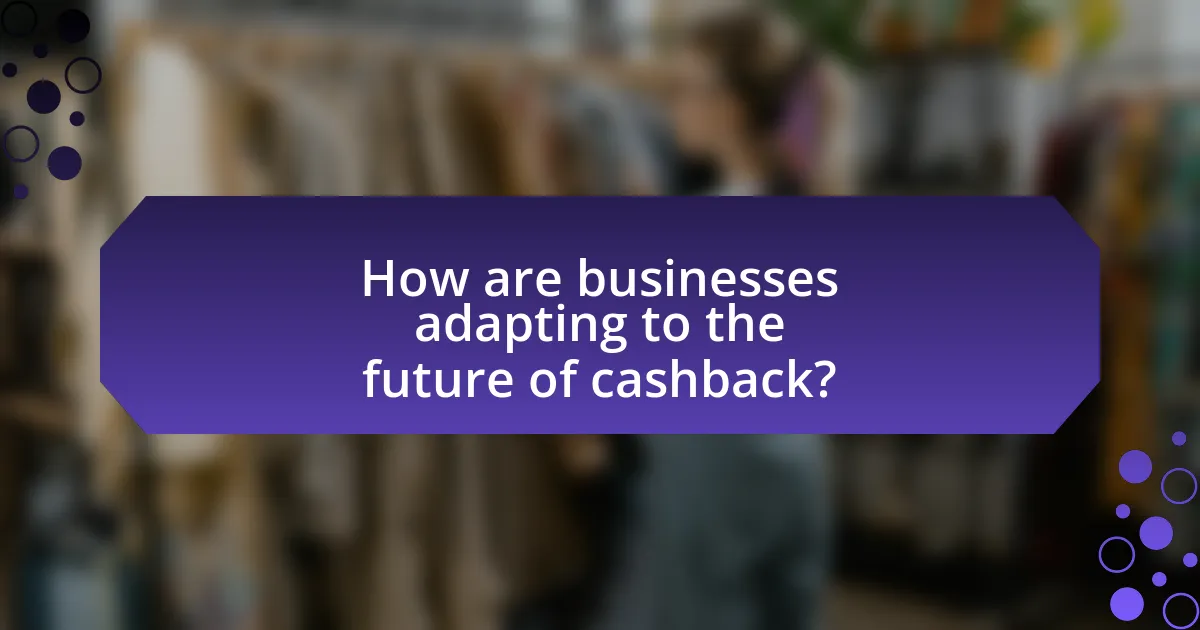
How are businesses adapting to the future of cashback?
Businesses are adapting to the future of cashback by integrating advanced technology and personalized marketing strategies. Many companies are leveraging data analytics to understand consumer behavior, allowing them to offer tailored cashback incentives that resonate with individual preferences. For instance, a study by McKinsey & Company found that personalized offers can increase customer engagement by up to 20%. Additionally, businesses are adopting mobile payment solutions and digital wallets, which streamline the cashback process and enhance user experience. According to Statista, the global mobile wallet market is projected to reach $7.58 trillion by 2027, indicating a significant shift towards digital solutions in cashback programs.
What strategies are retailers using to enhance cashback deals?
Retailers are enhancing cashback deals by leveraging personalized marketing, integrating mobile technology, and partnering with financial institutions. Personalized marketing allows retailers to tailor cashback offers based on consumer behavior and preferences, increasing engagement and redemption rates. For instance, retailers analyze purchase history to provide targeted cashback incentives, which can lead to a 20% increase in customer retention.
Additionally, the integration of mobile technology, such as apps and digital wallets, facilitates seamless cashback transactions, making it easier for consumers to access and utilize these deals. Research indicates that 75% of consumers prefer using mobile apps for cashback offers due to convenience.
Furthermore, partnerships with financial institutions enable retailers to offer exclusive cashback promotions linked to credit or debit card usage, enhancing the appeal of their deals. This strategy has been shown to boost sales by up to 30% during promotional periods.
How are partnerships between brands and cashback platforms evolving?
Partnerships between brands and cashback platforms are evolving towards more integrated and personalized consumer experiences. Brands are increasingly leveraging data analytics from cashback platforms to tailor offers that resonate with specific customer segments, enhancing engagement and driving sales. For instance, a report by eMarketer indicates that 70% of marketers believe personalized promotions lead to higher conversion rates. Additionally, brands are collaborating with cashback platforms to create exclusive deals that incentivize customer loyalty, reflecting a shift from traditional discounting methods to more strategic, value-driven partnerships. This evolution is supported by the growing consumer preference for seamless shopping experiences, as highlighted by a survey from Deloitte, which found that 80% of consumers prioritize convenience in their purchasing decisions.
What innovative marketing techniques are being employed in cashback promotions?
Innovative marketing techniques in cashback promotions include personalized offers, gamification, and integration with mobile apps. Personalized offers leverage consumer data to tailor cashback incentives based on individual purchasing behavior, increasing engagement and conversion rates. Gamification introduces elements such as challenges or rewards systems, encouraging users to participate more actively in cashback programs. Integration with mobile apps enhances user experience by providing seamless access to cashback deals, notifications, and tracking, which has been shown to boost user retention and satisfaction. According to a study by the National Retail Federation, 79% of consumers are more likely to engage with brands that offer personalized experiences, validating the effectiveness of these innovative techniques.
How are small businesses leveraging cashback to compete?
Small businesses are leveraging cashback programs to enhance customer loyalty and attract new clients. By offering cashback incentives, these businesses create a competitive edge against larger retailers, as consumers are more likely to choose a store that provides immediate financial benefits. For instance, a study by the National Retail Federation found that 70% of consumers are more inclined to shop at businesses that offer cashback rewards. This strategy not only increases foot traffic but also encourages repeat purchases, as customers are motivated to return to redeem their cashback.
What unique approaches are local businesses taking with cashback offers?
Local businesses are adopting unique approaches to cashback offers by integrating technology and personalization into their strategies. For instance, some businesses utilize mobile apps that allow customers to track their cashback rewards in real-time, enhancing user engagement and satisfaction. Additionally, local retailers are collaborating with community organizations to offer cashback incentives that support local causes, thereby fostering customer loyalty and community involvement. According to a study by the National Retail Federation, 70% of consumers are more likely to shop at businesses that support local initiatives, demonstrating the effectiveness of these tailored cashback strategies.
How can small businesses effectively measure the success of cashback programs?
Small businesses can effectively measure the success of cashback programs by analyzing key performance indicators (KPIs) such as redemption rates, customer retention, and overall sales growth. Redemption rates indicate how many customers are utilizing the cashback offers, providing insight into the program’s attractiveness. For instance, a redemption rate above 20% typically signifies a successful program. Customer retention can be assessed by tracking repeat purchases from customers who participated in the cashback program compared to those who did not, with studies showing that cashback incentives can increase customer loyalty by up to 30%. Additionally, overall sales growth can be evaluated by comparing sales figures before and after the implementation of the cashback program, with successful programs often resulting in a sales increase of 10% or more within the first few months.
What role do social media and influencers play in cashback promotions?
Social media and influencers significantly enhance cashback promotions by increasing visibility and engagement among consumers. Influencers leverage their established trust and large followings to promote cashback offers, effectively driving traffic to participating brands. For instance, a study by the Digital Marketing Institute found that 49% of consumers rely on influencer recommendations for their purchasing decisions, which directly correlates with increased redemption rates for cashback promotions. Additionally, social media platforms facilitate targeted advertising, allowing brands to reach specific demographics more efficiently, thereby maximizing the impact of their cashback campaigns.
How can brands utilize social media to boost cashback engagement?
Brands can utilize social media to boost cashback engagement by creating targeted campaigns that leverage user-generated content and influencer partnerships. By encouraging customers to share their cashback experiences on platforms like Instagram and TikTok, brands can enhance visibility and authenticity, leading to increased participation. For instance, a study by Sprout Social found that 79% of consumers are more likely to engage with brands that respond to their social media posts, indicating that active engagement can significantly drive cashback program participation. Additionally, offering exclusive cashback promotions through social media channels can create urgency and incentivize sharing, further amplifying reach and engagement.
What impact do influencers have on consumer perceptions of cashback deals?
Influencers significantly shape consumer perceptions of cashback deals by enhancing credibility and trust. Their endorsements often lead to increased awareness and interest in cashback offers, as consumers tend to value the opinions of trusted figures in their purchasing decisions. Research indicates that 49% of consumers rely on influencer recommendations when considering purchases, which directly correlates with their likelihood to engage with cashback deals. This influence is particularly pronounced among younger demographics, who are more susceptible to social media marketing.
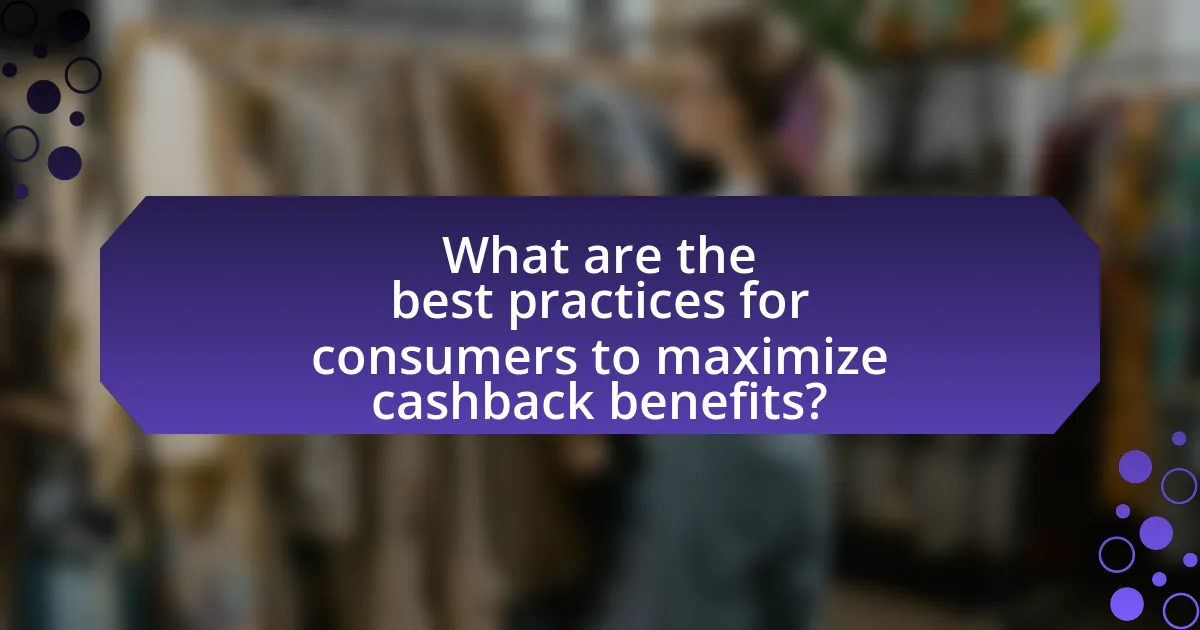
What are the best practices for consumers to maximize cashback benefits?
To maximize cashback benefits, consumers should strategically choose credit cards and shopping platforms that offer the highest cashback rates for their spending habits. Research indicates that consumers can earn up to 5% cashback on specific categories like groceries or gas by selecting the right cards, as many issuers provide rotating categories or bonus offers. Additionally, consumers should regularly review and adjust their spending to align with these categories, ensuring they take full advantage of promotional periods. Using cashback apps and websites can further enhance earnings, as they often provide additional rebates on purchases made through partnered retailers. By combining these strategies, consumers can significantly increase their overall cashback rewards.
How can consumers effectively choose cashback programs?
Consumers can effectively choose cashback programs by evaluating the percentage of cashback offered, the categories eligible for rewards, and any associated fees. Research indicates that programs offering 1% to 5% cashback on everyday purchases are common, while specialized categories may provide higher rates, such as 10% on groceries or dining. Additionally, consumers should consider the ease of redeeming cashback, as some programs require minimum thresholds or have expiration dates. A study by the Consumer Financial Protection Bureau highlights that consumers who compare multiple programs can maximize their savings, as different programs cater to varying spending habits.
What criteria should consumers consider when selecting a cashback platform?
Consumers should consider the cashback percentage, the variety of retailers, the ease of use, and the payout options when selecting a cashback platform. The cashback percentage directly affects the amount of money consumers can earn back on their purchases, with some platforms offering up to 10% or more on specific categories. The variety of retailers is crucial as it determines the shopping options available; platforms that partner with a wide range of retailers provide more opportunities for earning cashback. Ease of use is important for a seamless experience, including user-friendly interfaces and straightforward processes for claiming cashback. Lastly, payout options, such as direct deposit, gift cards, or PayPal, should align with consumer preferences to ensure convenient access to earned cashback.
How can consumers stay informed about the best cashback deals available?
Consumers can stay informed about the best cashback deals available by utilizing cashback websites and apps that aggregate offers from various retailers. These platforms, such as Rakuten and Honey, provide real-time updates on cashback opportunities and often feature user reviews and ratings to help consumers make informed decisions. According to a 2022 survey by Statista, 70% of consumers reported using cashback apps to maximize their savings, highlighting their effectiveness in keeping users updated on the latest deals.
What tips can help consumers optimize their cashback earnings?
To optimize cashback earnings, consumers should strategically choose credit cards that offer higher cashback rates on their most frequent purchases. For example, some cards provide 5% cashback on categories like groceries or gas, while others may offer 1% on all other purchases. Additionally, consumers can maximize earnings by using cashback apps and websites that provide extra rewards for shopping at specific retailers. According to a study by the Consumer Financial Protection Bureau, consumers can earn an average of 1% to 5% cashback depending on their spending habits and the rewards program they select. By aligning their spending with the best cashback opportunities, consumers can significantly enhance their overall cashback earnings.
How can strategic shopping habits enhance cashback rewards?
Strategic shopping habits can significantly enhance cashback rewards by optimizing spending patterns and leveraging promotional offers. By planning purchases around cashback categories, consumers can maximize their rewards; for instance, many credit cards offer higher cashback percentages for specific categories like groceries or gas. According to a study by the National Retail Federation, consumers who align their shopping with promotional periods can earn up to 5% more in cashback rewards. Additionally, utilizing cashback apps and websites can provide extra savings on purchases, further increasing the total cashback earned.
What common mistakes should consumers avoid when using cashback offers?
Consumers should avoid several common mistakes when using cashback offers, including not reading the terms and conditions, failing to track expiration dates, and overlooking eligible purchases. Not reading the terms can lead to misunderstandings about how cashback is earned, as many offers have specific requirements that must be met. Failing to track expiration dates can result in missed opportunities to claim cashback, as many offers are time-sensitive. Additionally, overlooking eligible purchases can lead to disappointment, as consumers may assume all purchases qualify when they do not. According to a survey by the National Retail Federation, 40% of consumers reported missing out on cashback due to not understanding the offer details, highlighting the importance of careful review.
What future developments should consumers watch for in cashback deals?
Consumers should watch for the integration of advanced technology and personalized offers in cashback deals. As artificial intelligence and machine learning evolve, cashback platforms are increasingly utilizing these technologies to analyze consumer behavior and preferences, leading to tailored cashback offers that maximize user engagement. For instance, a report by McKinsey & Company indicates that personalized marketing can increase conversion rates by up to 10 times, highlighting the potential effectiveness of such developments in cashback programs. Additionally, the rise of blockchain technology may enhance transparency and security in cashback transactions, fostering greater consumer trust.
How might upcoming technologies change the cashback landscape?
Upcoming technologies, such as artificial intelligence and blockchain, are poised to significantly transform the cashback landscape by enhancing personalization and security. AI algorithms can analyze consumer behavior to offer tailored cashback deals, increasing user engagement and satisfaction. For instance, a study by McKinsey found that personalized marketing can lead to a 10-30% increase in revenue. Meanwhile, blockchain technology can provide transparent and secure transactions, reducing fraud and ensuring that cashback rewards are accurately tracked and redeemed. This combination of AI-driven personalization and blockchain security is likely to create a more efficient and user-friendly cashback ecosystem.
What trends in consumer preferences could influence future cashback offers?
Trends in consumer preferences that could influence future cashback offers include a growing demand for personalized rewards, increased interest in sustainability, and a shift towards digital payment methods. Personalized rewards are becoming essential as consumers seek tailored experiences; for instance, a 2022 survey by Deloitte found that 80% of consumers prefer brands that offer personalized experiences. Sustainability is also a significant factor, with a 2021 Nielsen report indicating that 73% of millennials are willing to pay more for sustainable products, prompting cashback offers that align with eco-friendly purchases. Additionally, the rise of digital wallets and contactless payments, as reported by Statista, shows that 54% of consumers prefer using digital payment methods, which could lead to cashback offers integrated into these platforms.
